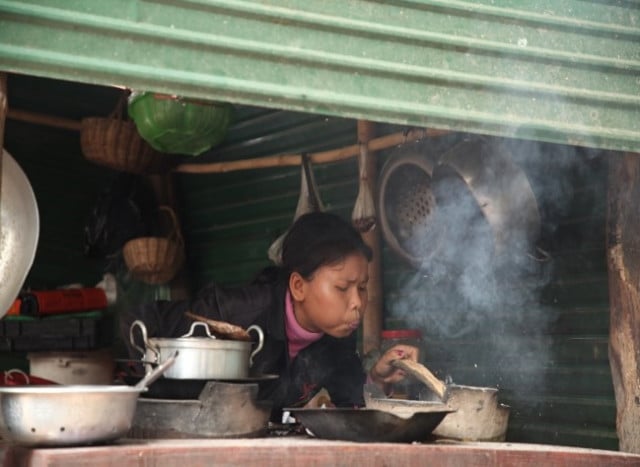Farmers Reap Rewards from Climate Initiative

- By Meng Seavmey
- December 22, 2023 10:50 AM
PHNOM PENH – Nearly 26,000 farming families in Prey Veng and Kampong Thom provinces have shifted from being vulnerable groups to active agricultural suppliers after climate-resilient infrastructure was built.
The works, including a canal and a dike, have provided better water management and control of floods which used to affect their crops.
In Neak Loeung town of Prey Veng province, the families have started economic activities along the main road linking the Neak Loeung bridge to the 4.3-kilometer dike, which provides them enough water for the plantation and prevents floods in the rainy season.
Funded by the Asian Development Bank, the dike is to mitigate seasonal flooding on the southeastern side of Neak Loeung town within 363 hectares, transforming it into an economic center to attract investment from public and private sectors.
The project was under the Cambodia Greater Mekong Subregion Southern Economic Corridor Towns Development Project, costing around $7.8 million and taking three years to construct. It created 1,720 jobs, of which 15% were for women, during construction.
The dike has a large retention pond, a pumping station, a drainage system, an electricity transformer, and a generator which were designed to convey, store and remove excess water from the protected area to ensure optimal water management.
Developing from vulnerable history
According to Vong Piseth, Undersecretary of State of the Ministry of Public Works and Transport, the geography and history of flooding were among the reasons the ministry chose the area.
It was not far from the main road, yet was not too near the Mekong River, he said.
“People in Neak Loeung town did not build their house far from main road due to inconvenient land, and there were no factories because the geography was not beneficial for traveling and settling in,” he added.
“However, the infrastructure and water control dike provided by this project now gets people’s interest in the land and agricultural activities.”
Before the dike, the farmers’ plantation had been dependent on the weather and floods decreased their products during rainy season. They rushed to harvest their crops before they were ready to avoid being flooded.
Improvement on student attendance and land value
The dike infrastructure makes it convenient for farmers and young people, especially women, to travel from the area to the main road with traffic safety signs, said Neak Sovath, chief of Neak Loeung village in Peam Ro district.
The road makes it safer to travel from the village to the main road for studies and work. Before the dike, they had to use boats to cope with floods.
“The villagers believe that there could be more economic activities — like selling and buying agricultural goods — in the future based on the dike and the convenient infrastructure from the main road, increasing incomes and jobs for the local people,” Sovath said.
He said farmers can now harvest their crops — including rice, corn, and bananas — two to three times a year due to the better water control.
With the transformation, the land value and incomes may have doubled because the area has become crowded. It is now a place for local people to gather, thus an economic center, said the village chief.
A small canal creates big development
Crossing Prey Veng province to Kampong Thom province, ADB also funded an agriculture cooperative and a rehabilitated canal in Sambo Meanchey district, under the Cambodia Tonle Sap Poverty Reduction and Smallholder Development Project - Additional Financing, known as TSSD- AF.
Costing around $230,000 for a concrete canal, warehouse, and drying pavement, the project increased harvests, incomes and job opportunities, especially women’s contribution to the village and the farmer association.
The canal extends the water flow to the end without being sucked into the soil, providing water all year round for the nearby plantation. With the stored water, more than 905 farmer families in Sambo village can harvest their crops two to three times per year, even in the dry season.
This encourages more planting and creates jobs for local people, especially housewives and those who used to be unemployed. The stored water has led to diversification of crops from only rice to lemongrass, cashew, cassava, coconuts and bananas and has responded to the climate efficiently, according to the farmers.
One of the beneficiaries, the Sambo Meanchey Agriculture Cooperative Association, has grown in membership and supplies for domestic markets. The farmer members include stay-at-home people, former unemployed people, and small-scale farmers, from growing as a family to supplying crossing provinces.
According to the association’s acting representative Pen Vuthy, they started with 88 members (50 females) to 1989 members (836 females), contributing to producing rice, rice seeds, lemongrass, cashew, cassava, coconuts, and bananas for domestic supplies.
The members have been able to expand their crops from family-level plantation to domestic supplies of rice seeds, lemongrasses, kinggrasses, watermelons, bananas, and pineapples because of enough water storage. Their biggest market is Phnom Penh capital.
Grow at home, supply across the country
Mam Kimhong, the chair of the association's committee and a farmer, said there used to be a potholed road and water shortage for farmers before the project initiative. The farmers used to harvest well only when there was enough rain, as the soil sucked the stored water shortly after the rain.
"We only grew rice once a year before and never planted lemongrass for supply. But we can now harvest rice two to three times a year, and are able to supply lemongrass domestically. It's a development," she said, adding that all of their harvests are always sold out.
Kimhong, 42, added that the association shows the models to the farmers, and the farmers get interested in helping the association as members. Types of crops for supplies are ensured by the association's markets, so that they will not go to waste.
Phon Sarith, 45, expressed his delight for the concrete canal constructed for farmers. He said, "Not only does the canal help store water, it also ceases the conflict of interest between farmers who used to compete for water for their own farms."
There are no longer disputes because the canal is for everyone and is enough for the plantation for both personal consumption and domestic supply, Sarith added.
Sarith grows rice and lemongrass twice a year. Before the canal, he only produced two to three tonnes of rice per hectare, but the harvest now reaches six to seven tonnes per hectare with enough stored water in the canal.
"Everyone, whether at farms or homes, can earn from growing these crops today with the help of association and the canal," he said, adding that despite the convenient plantation, there is a specific quality of the products that meet the expectation of the customers the farmers have to follow.
ADB’s commitment continues
Jyotsana Varma, country director of ADB for Cambodia, was satisfied with the success of the projects which contributed significantly to the livelihood of local people in education, economic, and agricultural sectors, especially women’s roles in economic development.
“When there are more incomes, there will be education and more agricultural businesses within the area. The outcome motivates me and the team,” she said.
“Although it might seem like small interventions, it allows the farmers certainty over the crops they can produce. There are also crops they have to get a better price on the markets,” she said.
The country director was impressed by the ability of the association to negotiate good prices and grow on their own with only a small intervention from the bank.
Jyotsana added that the outcome was not the end of the team’s work, as there would be a working group to follow up with the studies on the impact of the subprojects if necessary to improve shortcomings.
The Asian Development Bank is one of the biggest development partners in Cambodia, providing loans and grants to support in sectors ranging from project and technical assistance to trade and supply chain, with average annual lending of $368 million in 2018–2022.
As of September of 2023, the bank has supported Cambodia with 331 public sector loans, grants, and technical assistance totaling $4.6 billion.















